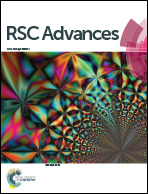Mechanistic study of selective catalytic reduction of NO with NH3 over highly dispersed Fe2O3 loaded on Fe-ZSM-5
Abstract
ZSM-5 supported highly dispersed FexOy clusters were prepared by a sol–gel method for selective catalytic reduction (SCR) of NO with NH3. XRD, SEM, UV-vis, H2-temperature-programmed reduction (H2-TPR), NH3-temperature-programmed desorption (NH3-TPD), and BET analyses all indicated that Fe species mainly existed as highly dispersed surface FexOy clusters with a Fe3+ concentration of 22 wt%. NO-temperature-programmed oxidation (NO-TPO) revealed that the FexOy clusters promoted the oxidation of NO to NO2, which promoted the low temperature NOX removal. NH3 was activated above 250 °C and over-oxidation of NH3 to NOX was not observed, as a result, a NOX removal efficiency of 91% was achieved at 400 °C. Moreover, the SCR reaction route was found to be temperature dependent, below 200 °C, the NOX reduction followed the reaction between NO2 and non-activated NH3. Fast SCR reaction dominated the NOX removal in the temperature window of 200–325 °C. At temperatures above 250 °C, the normal reaction between activated NH3 and NO compensated the thermodynamic limitation induced suppression of fast SCR.


 Please wait while we load your content...
Please wait while we load your content...